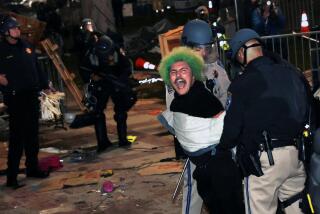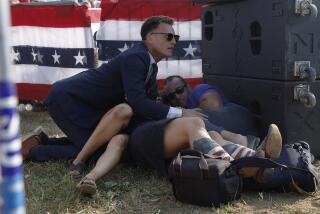Coming Down Hard
- Share via
With billboards, television spots and speeches, Los Angeles police are seeking again to ram home a basic law of physics as New Year’s Eve approaches: Bullets fired into the air hurtle back to Earth with deadly force.
“There is no need to risk someone else’s life to have a good time on New Year’s Eve,” City Councilman Joel Wachs said Monday, joining Deputy Police Chief Martin Pomeroy and City Atty. James Hahn to publicize the city’s seven-day ban on ammunition sales for the week leading up to, and including, New Year’s Day.
Their appearance was part of a decade-long publicity blitz drumming in the message that celebratory bullets fired randomly into the air can kill, and those who shoot them can spend three years in prison.
The aim is to head off people more mindless than malicious--the intoxicated revelers who fire at the sky in the mistaken belief that their bullets vanish harmlessly into the heavens.
In fact, a bullet fired up will come barreling down at virtually the same speed it left the muzzle. “There is a little lost for air friction, but not much. Bullets are very aerodynamic,” said UCLA physics staff member Martin Simon.
Perfectly vertical shots will return to Earth close to where they were fired; pistol bullets fired at even a small angle will follow an arc that could bring them down blocks away. Rifle shots can travel several miles.
The result has been a slew of gunshot wounds and close calls over the years--and occasional deaths.
The present campaign began around the same time that police officers at the 77th Street Division got fed up with the hail of bullets, and put a tape recorder in the back of a patrol car on New Year’s Eve.
The gunshots they recorded helped make their point vividly to policymakers, and a cause was born. “The tape sounded like Beirut,” said Wachs, author of the ammunition ban.
Shooting into the air was made a state felony in 1988. The citywide ban on sales, gifts or loans of ammunition--also in force for the week of the Fourth of July--came in 1990. Since then, the “what goes up, will come down” campaign has steadily gained momentum.
Everyone from school district officials to celebrities such as James Garner have pitched in over the years.
This year, schoolchildren throughout the Los Angeles Unified School District were asked to participate in essay and poster contests. Nine-year-old Tiara Hoyt of Carson and Gardena fifth-grader Eric Hernandez were the respective winners.
Opinions differ as to how many people have fallen victim to random gunfire. An LAPD spokesman said the department has been unable to come up with reliable figures, that there are discrepancies in some tallies.
A study by Martin Luther King Jr./Drew Medical Center physicians said that between 1985 and 1992, 38 people died of celebratory gunfire on New Year’s and the Fourth of July. Police put the number at less than half a dozen in the same period.
More to Read
Sign up for Essential California
The most important California stories and recommendations in your inbox every morning.
You may occasionally receive promotional content from the Los Angeles Times.










